ISBN 978 1 78412 503 5
DPPAS 30387
This document is also available in pdf format (960 KB)
Contents
Chapter 2 Summary of Inspections Undertaken
Chapter 3 Review of the Prison Inspectorate's Year 2013-14
Chapter 4 Business Plan 2014-15
1. Overview
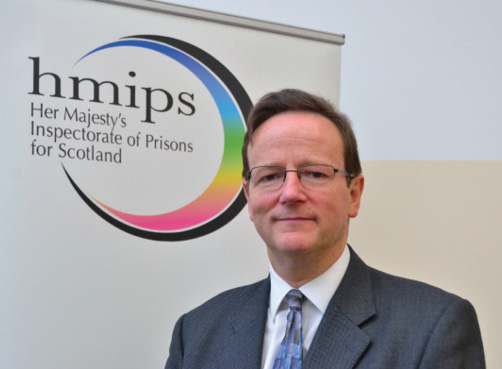
David Strang QPM
HM Chief Inspector of Prisons for Scotland
Introduction
I am pleased to present my first annual report, having been appointed as Her Majesty's Chief Inspector of Prisons for Scotland (HMCIPS) in June 2013. I would like to pay tribute to my predecessor, Hugh Monro, who for four years exercised his duties with considerable passion and energy. In his final report last year he highlighted the four priorities which he had pursued as HMCIPS: care of female offenders; family access; purposeful activity in prison; and preparation for release. I am pleased to be able to build on the progress he made in these areas.
Initial Impressions
In my first report, I would like to articulate some of my first impressions on taking up the post of HMCIPS. In my first six weeks, I visited every prison and young offenders institution in Scotland. This was a very useful introduction to my new role and to the work of the Scottish Prison Service.
This was not my first venture into prisons, as I was a member of the Scottish Prisons Commission (2007-08), which produced its report 'Scotland's Choice' in 2008 (http://www.scotland.gov.uk/Publications/2008/06/30162955/0) which contained 23 recommendations on the future use of imprisonment in Scotland. Many of the observations and recommendations in that report remain relevant today, particularly those relating to minimising the use of imprisonment and increasing the use of effective community sentences.
In terms of formal reporting, the Inspectorate has this year conducted three full inspections - HMP Low Moss, HMP Edinburgh and HMP Inverness - and two follow-up inspections - HMP Barlinnie and HMYOI Polmont. Details of these inspections and the findings are included in Chapter 2 of this report.
As I have learnt more about prisons in Scotland, my early response as HMCIPS has been to appreciate the complexity of the task of running a prison and caring for prisoners. Each prison contains a wide variety of people, often with complex, and competing, needs. Some people are difficult to deal with - demanding and vulnerable; others are more compliant and willing to engage. They have to be managed within a framework that is consistent and fair to all.
We expect prisons to be well run and successful at achieving their purpose. I have considered the challenges in the context of the purposes of imprisonment which seem to me to be potentially competing with each other. In 2012, the Scottish Government published its 'Strategy for Justice in Scotland' (www.scotland.gov.uk/Publications/2012/09/5924/0) which articulated a 'vision of a justice system that contributes positively to a flourishing Scotland, helping to create an inclusive and respectful society, in which all people and communities live in safety and security, individual and collective rights are supported, and disputes are resolved fairly and swiftly'. The prison service has an important contribution to make to the safety and security we want from our criminal justice system.
The Strategy identifies three purposes for a prison sentence:
- To punish serious offenders appropriately
- To protect communities from harm
- To offer the opportunity for rehabilitation.
It is clear to see how a long prison sentence can protect the public from those who pose a serious risk of harm. Any prison sentence, depriving an individual of their liberty, is a punishment. For me, the complexity arises in our expectation that imprisonment will contribute to reducing reoffending. There is inevitably a tension between the requirement for punishment (with its accompanying deprivation of liberty and restrictions of choice) and the desire for rehabilitation (with its aspiration to engender a sense of responsibility and encourage preparation for release as a positive, contributing citizen).
It is disappointing to note that since the publication of 'Scotland's Choice', the overall prison population has continued to increase. This is a cause for concern. While it is encouraging that there is a downward trend in the number of young offenders detained, more should be done to reverse the increase in adult population. I would expect the prison service more actively to progress prisoners on longer sentences towards lower levels of supervision in preparation for release. This would include greater use of Home Detention Curfews.
The prison service has considerable opportunities to work with prisoners constructively to reduce their likelihood of reoffending after their release. Prison staff spend long periods of time with those detained in prison and work with them in different ways throughout their sentence. In my view there is great potential to have a deeper impact on the lives of those in prison and to contribute to a safer and stronger Scotland.
Civilised Society
An effective criminal justice system which commands the confidence and trust of the public generally, and especially those who participate in it, lies at the heart of a civilised society. Justice should be achieved for all whose lives are impacted by the system. Well run prisons form an essential element of such a successful system. A civilised prison is one where all who are detained are treated with dignity and respect, as human beings deserving of fundamental rights, no matter what crime they have committed nor how they behave.
People deprived of their liberty are vulnerable and at particular risk of human rights violations. Securing their safety and well-being are the responsibility of the detaining authority, which should therefore guarantee conditions of detention that respect human rights and human dignity. Inspecting the conditions of detention forms an integral part of the overall system for protecting people who are deprived of their liberty.
The Inspectorate
One of the main functions of the Prisons Inspectorate is to counter the risk that those who are detained will be subject to mistreatment. The United Kingdom is a signatory to the United Nations Optional Protocol to the Convention Against Torture and Other Cruel, Inhuman and Degrading Treatment or Punishment (OPCAT). HMIPS is one of 20 bodies which comprise the National Preventive Mechanism, which has a duty regularly to monitor the treatment of detainees and the conditions in which they are held.
My legal duty as HMCIPS is to inspect prisons and to report on the conditions in prison and the treatment of prisoners. I do this as an outsider in relation to prisons. One strength of the Inspectorate is that we are independent in our inspecting - independent of the Scottish Prison Service, and independent of the Scottish Government. This is a fundamental element of our inspection and monitoring role. Those who form the inspection teams come from a variety of backgrounds. Some are seconded from the Scottish Prison Service who bring essential professional expertise and experience; others are expert inspectors from other specialist agencies such as Healthcare Improvement Scotland, Education Scotland and the Care Inspectorate. I am grateful to all those who have supported the inspections in this way throughout this last year.
A second strength of the Inspectorate's approach is that our recommendations are evidence-based. We inspect against a set of published inspection standards and ensure that any recommendations we make flow from the evidence which we have found. This includes researching data and information from prison records, interviews, focus groups with staff and with prisoners and observations of current practice in the prison. The standards against which we inspect focus more on the outcomes for prisoners and less on the prison's processes. Inspections cover the full range of prison life, from the basic essentials such as the physical environment, bedding, clothing and food, through healthcare, to how prisoners are treated as people. An important element is how well prisoners are prepared for release and what opportunities they have for shaping their futures. Our follow-up inspections allow us to monitor the prison's progress in implementing the recommendations of the full inspection reports.
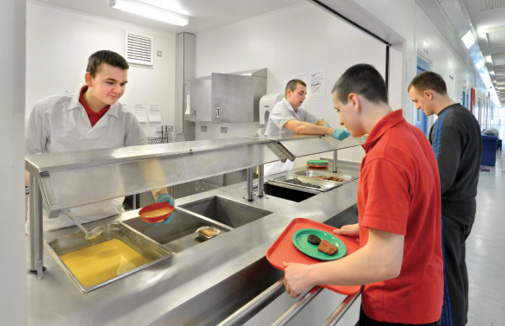
Serving food at HMYOI Polmont
I am always keen that when we inspect a prison we identify areas of good practice as well as recommending areas for improvement. Our reports are published and reported widely, thus ensuring greater transparency and public scrutiny of our prisons.
Context - Scottish Prisons
The year 2013-14 has seen a number of significant changes for prisons in Scotland. In terms of the prisons estate, both HMP Peterhead and HMP Aberdeen closed, and were replaced by a newly built HMP & YOI Grampian in Peterhead. HMP & YOI Grampian has the capacity to hold 500 people and will house adult male prisoners, adult women offenders and young offenders. As the prisons estate is modernised, the older prisons stand out more as physically inadequate. These physical conditions present an additional challenge for staff to provide appropriate care in what would be unacceptable design in a modern prison.
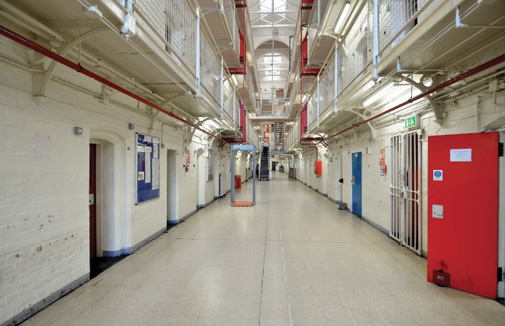
Victorian built Hall at HMP Barlinnie
There has also been a significant turnover of senior staff both in prisons and at the SPS Board level.
Most significant has been the publication of the report of the Scottish Prison Service's Organisational Review in November 2013. This report, entitled 'Unlocking Potential, Transforming Lives'-
www.sps.gov.uk/MediaCentre/Organisational_Review_Published.aspx - was the product of a 15-month comprehensive examination of the vision, values and core business of the SPS. The service is now in the process of implementing the review, in what has the potential to be a major strategic change.
A clear message from the review which I found striking was the intention to take an individualised, assets-based approach to building on people's strengths and potential. So often, I hear people in prisons being defined and described by the problems they face, the difficulties they have endured, their vulnerabilities, their poor health and prospects, by what is wrong in their lives. Whilst these are no doubt accurate as facts, I welcome the approach articulated in the review, which will concentrate on supporting people to focus on their potential and to encourage positive links with the communities to which they will return. This will increase the likelihood of successful reintegration and contribute to reducing reoffending.
The review recognises the requirement for further staff development to equip the service to deliver the new vision. If the role of the prison officer is to change substantially, they will need to be trained and supported in their revised functions.
The Public Social Partnerships which have been established this year are beginning to have a greater impact as more prisoners are supported by mentors both in preparation for release and in the first weeks and months after release. I have been impressed with the levels of partnership working with the third sector organisations in delivering these valuable services. I look forward to observing the implementation of the new strategy and in particular its impact on the lives of those in prison as they make the journey back into the community.
Inspection findings
I would like to comment on the findings from across our inspections this year, following the structure of our inspection standards: safety, decency and opportunity. I will highlight particular areas of good practice and comment on significant recommendations, particularly where these have been repeated in subsequent inspection reports.
Safety: Security, good order, protection from harm
A fundamental requirement of a well-run prison is that it should keep those detained there safe. Whilst there is always potential for bullying, violence and aggression, broadly speaking, prisons in Scotland are safe places. Prisoners generally report feeling reasonably safe. Levels of assault are always a matter of concern; most prisons have an effective violence reduction strategy in place and implement the anti-bullying strategy, although this is not universal. I do not consider that any level of violence is acceptable and prisons must continually seek ways to reduce the levels of violence.
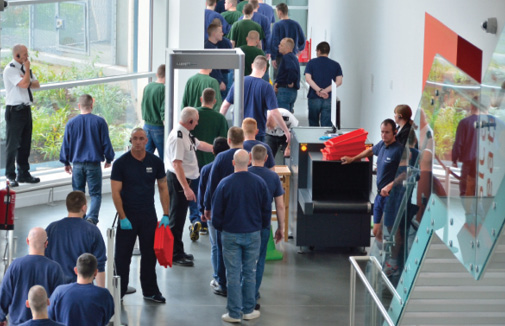
Route movement security checks at HMP Low Moss
The management of prisoners at risk of suicide or self-harm remains a challenge for the service. ACT 2 Care provides a good basis for looking after those who are vulnerable and have mental health problems.
Recurring recommendations
The first few hours and days in custody represent a particularly vulnerable time for prisoners newly admitted. The information which accompanies the prisoner on admission contains potentially vital information to assist those with the responsibility of caring for them in that early period in custody. A recurring feature we have highlighted in our reports is that too often important information on the Prisoner Escort Record form is communicated neither to the healthcare staff nor prison officers who are conducting initial assessments on admission at reception. This increases the risk that important information about previous incidents, mental health issues or other vulnerabilities are not passed on to those who need to know.
Similarly, the requirement to search prisoners thoroughly as soon as possible, with the use of the Body Orifice Security Scanner chair is too often not complied with. This allows the potential for someone to have a concealed weapon while they are being interviewed by prison or healthcare staff.
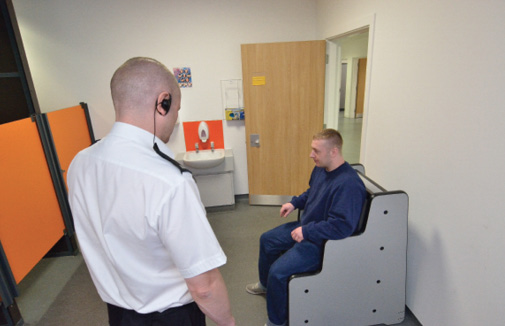
BOSS Chair in use at HMP Low Moss
We also found that healthcare notes do not always accompany the prisoner on transfer from another establishment. This is important to ensure that they receive the correct medications they are due.
On a number of occasions, we have recommended that the cells where vulnerable prisoners are looked after under ACT 2 Care should be upgraded to make them safer and free from potential ligature points.
Our reports made several recommendations concerning infection control, particularly in relation to the cleaning of cutlery and crockery used for meals in halls and cells. On too many occasions we found that prisoners were retaining cutlery and crockery in their cells and washing them in their cell wash hand basins, without the necessary means of ensuring proper hygiene.
Finally, we commented adversely on the allocation of prisoners to cells where this resulted in both untried and convicted prisoners sharing a cell. This is unacceptable.
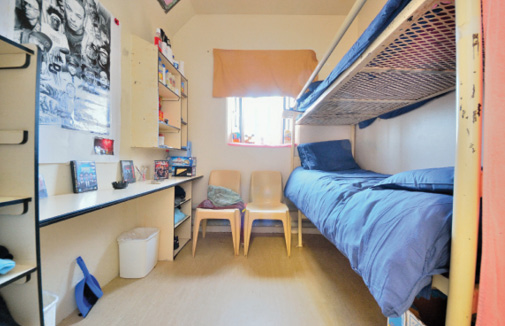
Double cell at HMP Edinburgh
Decency, Humanity and Respect for Legal Rights
Respect for human dignity should be apparent in the way that prisoners are treated at all times and in the conditions in which they are held. Wherever possible, prisoners should be involved in making decisions and able to exercise some choice and responsibility.
A key factor in the treatment of prisoners is the relationship between prisoners and all staff who work in the establishment. Overall, I have been impressed with the quality of these relationships. I have observed positive interactions between staff and prisoners, and many prisoners report that they are well treated and know how they can obtain assistance if they have a problem. There are, of course, some exceptions, but I have seen many instances where staff have provided considerable assistance and encouragement in order to support prisoners in addressing the challenges they face.
Recurring recommendations
While the quality and improved fabric of the newer prisons in Scotland undoubtedly provides a better environment for prisoners to live in, the issue of overcrowding still remains. Prison cells designed for single occupancy are regularly used to house two prisoners. This has a detrimental effect on the conditions for the prisoners. Regular overcrowding also reduces the ability of the prison to provide sufficient work, education, exercise and access to facilities such as the gymnasium and library.
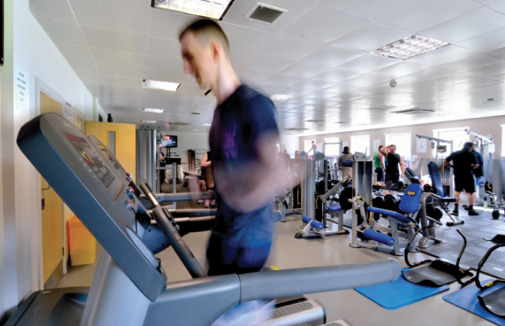
Cardio-training in the gym HMYOI Polmont
The use of separation or segregation is a subject we pay particular attention to. Prisoners who require to be held away from the main accommodation areas are often a challenge to manage, either because of their behaviour or vulnerability. It is my intention in the year ahead to conduct a thematic inspection of the use of separation throughout the prisons estate. We have been particularly concerned about the care and management of prisoners on a 'dirty protest' and the health implications of prolonged protests, from both a mental health and an infection control perspective. The cleaning of such cells poses a real challenge and has potential long-term implications for the fabric of the cells.

Cell within Separation and Reintegration Unit HMP Edinburgh
Opportunities for self-improvement and access to services and activities
A major focus of the work of prisons should be to assist prisoners in their preparation for release. The opportunity for constructive engagement in activities which will lead to successful resettlement will contribute to a reduction in reoffending. The vast majority of prisoners will return to the community from which they came. It is therefore important to build on positive relationships with families and organisations in the community.
There is a range of work activities and education available in all prisons, some more relevant to employment opportunities in 21st Century Scotland than others. A key emphasis of the Scottish Prison Service's Organisational Review is to improve those opportunities and to maximise their relevance and effectiveness.
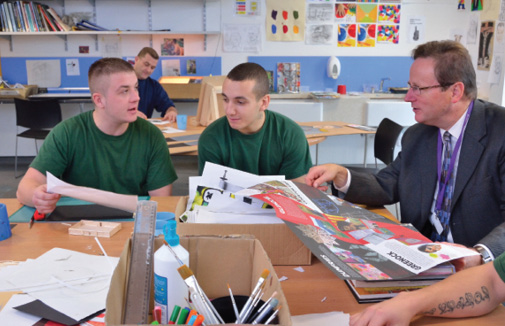
Learning activity - Art class HMP Low Moss
The provision of healthcare is an important factor in how a prisoner is treated and how well they are prepared for their return to the community. In general, healthcare in prisons is positive, with, in many cases, a good relationship between the prison and the NHS Board responsible for meeting the healthcare needs of those in prison.
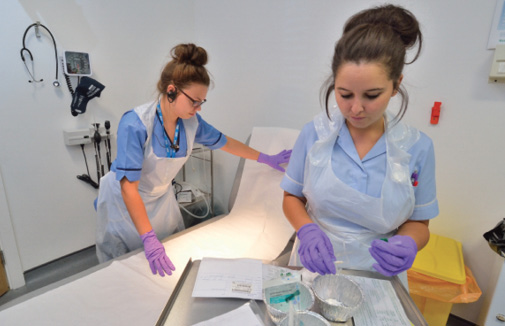
Healthcare at HMP Low Moss
There are some good examples of throughcare which supports the transition from the prison to the community. The issue of an ageing prison population is a growing one. This provides particular challenges where prisoners have increasing levels of disability and dementia, and are needing higher levels of medical interventions and high health and social
care needs.
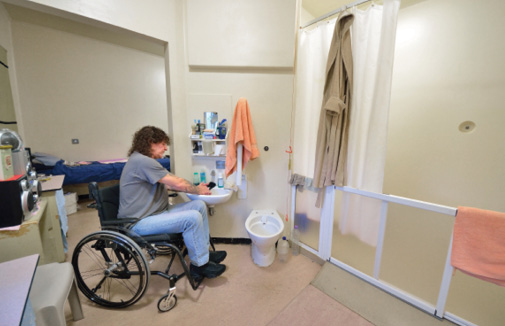
Disabled Cell at HMP Edinburgh
Recurring recommendations
A frequent recommendation in our reports has been to increase the access to purposeful activity available to all prisoners. While there are examples of excellent facilities, work programmes, training and education, these are often still not sufficient to meet the needs of the prison population. In some prisons there are simply not enough places available; in others they are not used to their maximum effect. A number of prisons are conducting reviews of their timetabling for prisoners' attendance at work and education, together with reviewing the attendance patterns for staff. Empty worksheds resulting from too few qualified instructors represent a disappointing level of wasted opportunities.
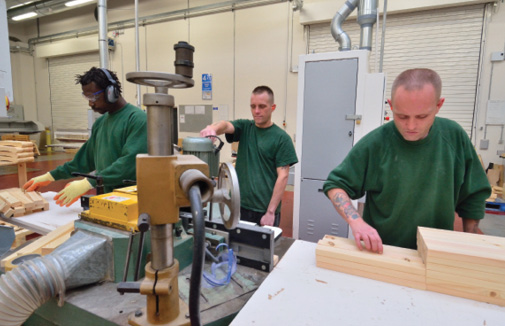
Timber workshop at HMP Low Moss
The role of the Personal Officer in supporting prisoners is key to engaging prisoners successfully in making the most of the time they spend in custody. Where officers have been trained well and put that training into practice, positive outcomes result.
We have recommended that such training needs to be delivered for all those who have the responsibility as Personal Officers.
Areas of Good Practice
I would like to highlight a few areas where I have been particularly impressed with the developments I have seen in prisons in Scotland.
The Scottish Prison Service encourages Governors to exercise a degree of autonomy and innovation in how they fulfil their responsibilities. I acknowledge a strength in this, but I would still like to see a greater uptake of learning from one prison to another, building on good practice discovered through pilots, initiatives and their evaluation.
Family contact
The importance that the family can make in the life of the prisoner has been recognised. Greater emphasis has been placed on maintaining positive family contacts and encouraging engagement, particularly with the children of those in custody.
I have witnessed some encouraging family visits, which are designed to build positive relationships within the family. This will not be appropriate in every situation, but where it is, it has the potential
to be positive for both the family and the prisoner.
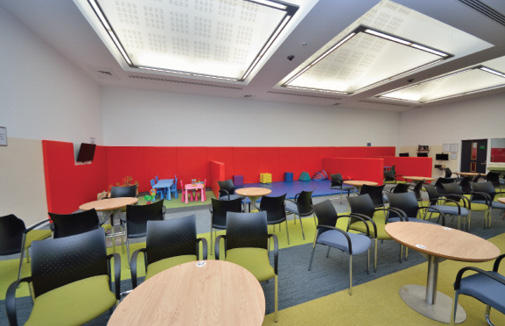
Children's play area within Visits at HMP Low Moss
Similarly, the development of family centres or help hubs at a number of prisons is providing support to families and helping them to maintain positive links with those in prison. In September, I was at the official opening of the family help hub at HMP & YOI Cornton Vale and was encouraged by the quality of the facility and the support services being offered. A number of other prisons are also developing such initiatives.
Links to Third Sector and partner organisations
Each week, a large number of people from Third Sector and partner organisations attend prisons to work constructively with prisoners. I have been impressed with the quality and quantity of these initiatives and programmes. The introduction of Public Social Partnerships is designed to deliver greater benefit from joint working between prisons and partner organisations. In their early days there are clear signs of positive results from mentoring and other forms of support. At HMP Low Moss there is an impressive level of volunteering by people who regularly attend to provide support to prisoners.
Young people's strategy
A great deal of work has gone into developing a strategy for young people in custody. I saw this clearly during our follow-up inspection of HMYOI Polmont in March 2014, where considerable progress has been made in creating a learning environment. There is without doubt great potential for this to have a positive impact on those young people, to support them in preparing for a positive future that does not result in them returning to custody. The strategy should apply to young people in HMP & YOI Cornton Vale and now HMP & YOI Grampian too.
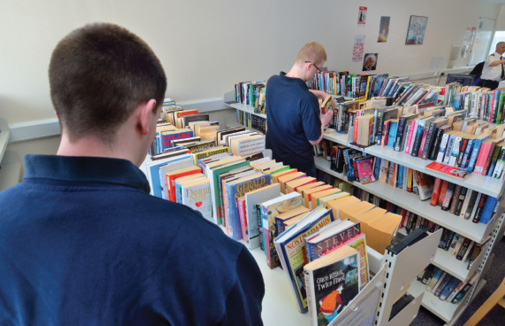
Library at HMYOI Polmont
Women offenders
Following the publication of the report of the Commission on Women Offenders in 2012, plans continue for the design and development of HMP Inverclyde, a national facility to replace HMP & YOI Cornton Vale. In the meantime, I am pleased to note the considerable investment to improve the living conditions at Cornton Vale. In addition to HMP Greenock, the new HMP & YOI Grampian also holds women offenders. HMP Edinburgh will have a further regional unit for women, now in its design stage.
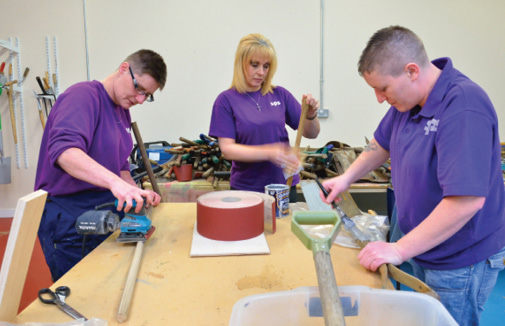
Garden Tool refurbishment work party at HMP Edinburgh
HM Inspectorate of Prisons for Scotland
In addition to conducting the inspections detailed in Chapter 2, the inspectorate has also progressed the following areas of work over the last twelve months.
Standards
The standards currently used in the inspection of prisons in Scotland were published in 2006 and do not now reflect adequately the requirements of prisons inspection. Throughout this year, we have conducted a process of revision of the standards, which has included consultation with practitioners, academics and others with an interest in human rights and how prisons are run. The evolving standards will have a greater emphasis on engaging prisoners in decision-making, improving the clarity of purpose and priorities of the prison and assessing relationships both within the prison and with external agencies and communities.
We expect to finalise the standards over the next few months and to begin to use them in our inspections later this year.
Independent Prison Monitoring
Following the announcement last year by the Cabinet Secretary for Justice that Prison Visiting Committees are to be replaced by a system of Independent Prison Monitoring, HMIPS has been actively involved in the process of planning for the new monitoring system. The legislation which is required to enable the changes is currently being considered by the Scottish Parliament. This is a significant and important change to the arrangements for independent monitoring of prisons and will bring the responsibility for the oversight and co-ordination of such monitoring under the auspices of HM Chief Inspector of Prisons for Scotland.
Complaints handling procedures
In line with best practice for public sector organisations, HMIPS has published a complaints handling process, which is clearly articulated on our website. This process complies with the Scottish Public Services Ombudsman's guidance on a model of complaints handling procedure.
National Preventive Mechanism (NPM)
HMIPS is one of 20 organisations that comprise the UK National Preventive Mechanism. As HMCIPS, I am one of five members of the NPM Steering Group, which has responsibility for facilitating co-ordination and decision-making between biannual business meetings of the NPM.
Business Plan 2014-15
Included in Chapter 4 of this report is the Business Plan for HMIPS for the coming year 2014-15. This sets out the planned activity of the Inspectorate for the next 12 months.
I would like to thank the staff of HMIPS for their dedication and commitment throughout this busy year and to express my appreciation for their assistance in my first year in office.
Conclusion
The vast majority of those currently detained in prison will return to the community in which they lived before they were imprisoned. For some, this will be in a short time; for others it may be in several years' time. Many will be described in terms of the challenges and problems they have faced - broken relationships, substance misuse and addictions, mental health problems, unemployment, lack of educational achievement, offending background and harm they have caused to others.
But all are human beings with potential; people capable of change and growth. The challenge for society and for the prison service is to identify that potential and to prepare them for responsible citizenship after their sentence is served.
David Strang
HM Chief Inspector of Prisons for Scotland
June 2014
2. Summary of Inspections Undertaken
Establishments
HMP Low Moss
Full Inspection 13-21 May 2013
Summary
Safety
HMP Low Moss provides prisoners who have mental health, alcohol or drug problems, or are at risk of self-harm or are vulnerable for other reasons with appropriate services and support.
Contingency plans are in place to deal with a range of possible emergency situations.
In line with SPS policy and procedures force is only used as a last resort.
HMP Low Moss does not use the SPS Anti-Bullying Strategy (ABS) to any great extent. HMP Low Moss should ensure that the ABS is invoked as required.
The application of the Prisoner Supervision System (PSS) in HMP Low Moss is fair. In particular, risk factors are duly considered and representation from prisoners is taken into account. This ensures the review process is transparent and objective. It was noted that that timescales for review are not always met.
Decency, Humanity and Respect for Legal Rights
Prisoners within HMP Low Moss are treated with decency, humanity and their legal rights are respected.
Food is adequate for health, varied with special dietary requirements in terms of religious and medical needs catered for. Portion sizes are adequate. Food is delivered to the house blocks in trolleys, however due to the design of the trolleys occasionally food may deteriorate to a degree during transportation. Fruit and vegetables are offered daily.
In-cell space, natural light and ventilation are adequate. Cells provide access to drinking water and toilet and showering facilities. General storage within cells is poor with limited cupboard space. Only one under-bed storage box is provided per prisoner and there is no provision at all for hanging clothes or other items such as towels. This has resulted in improvised clothes hangers and storage items being made and fitted by prisoners in many cells.
A recently introduced physical education programme offers a more structured approach in its delivery by prison staff. The programme is also encouraging a better uptake of activities by prisoners. More targeted age and ability classes, such as over 50's yoga, are better meeting the needs of the whole prisoner population.
Relationships between prisoners and staff are good.
Prisoners can access Prison Rules and a selection of legal texts via the Library.
Prisoners are able to receive visits from their families and friends in a large, modern and well-furnished facility. There is no limit on the number of visits. Of particular note are the dedicated children's visits which encourage and develop positive parenting skills for fathers and is an area of good practice which should be replicated where appropriate across the Scottish Prison Service.
Prisoners can access telephones and postal services. Legally privileged correspondence is dealt with appropriately.
Disciplinary hearings for prisoners are dealt with by HMP Low Moss fairly and justly.
Opportunities for self-improvement and access to services and activities
HMP Low Moss aims to provide prisoners with 35 hours of purposeful activity per week. Whilst this is not delivered for all prisoners, the highest level within SPS public sector prisons of purposeful activity is achieved. This is to be commended.
The Learning Centre provides a welcoming and well-presented environment for prisoners to engage in purposeful learning activities. The centre is well-equipped overall and prisoners are able to access a range of learning resources appropriate to their studies. Around 35% of prisoners attend education classes each month for at least one session per week. Both convicted and untried prisoners attend classes but uptake from untried prisoners is low.
The library is not open in the evening or at weekends. Attendance figures are low. (Daily average of eleven against a prison population of 700+). The library is not well stocked. Links to local authority library services are not yet fully established.
Healthcare is generally well-delivered but Pharmacy arrangements in place are inconsistent.
Recommendations
For the Establishment
HMP Low Moss should provide written information for prisoners in a number of languages other than English.
HMP Low Moss should ensure that prisoners can read the written information issued to them.
HMP Low Moss should introduce a system which gives assurance that night patrol routes and observations are being undertaken properly.
HMP Low Moss should ensure that there is adequate first aid cover within the establishment at all times.
HMP Low Moss should ensure fire awareness training targets are met.
HMP Low Moss should ensure cell door observation panels are not covered up.
HMP Low Moss should ensure that all night duty visits are recorded.
HMP Low Moss should ensure that the Head of Operations completes Section I of the Use of Force Reporting Form.
HMP Low Moss should ensure the SPS Anti-Bullying Strategy is implemented.
HMP Low Moss should ensure that all Prisoner Supervision System reviews are undertaken within the prescribed timeframes.
HMP Low Moss should identify an appropriate area within cells for the display of photographs.
HMP Low Moss should remove all storage items outwith the original cell design and provide prisoners with sufficient, appropriate storage facilities.
HMP Low Moss should ensure suitable areas for drying clothing used by prisoners accessing time in the open air are provided.
HMP Low Moss should ensure that a sufficient stock of better quality tee-shirts for issue to prisoners is procured and maintained.
HMP Low Moss should ensure that the arrangements for storing and serving breakfast cereals are safe and hygienic.
HMP Low Moss to consider moving to the alternative trolley design.
HMP Low Moss should ensure that prisoners have the means to properly wash their cutlery and crockery.
HMP Low Moss should ensure that all rub down searches are carried out to the same recognised standard.
HMP Low Moss should ensure that the complaint process flowchart is posted for prisoners to see in all Residential areas.
HMP Low Moss should ensure prisoners do not attend court in prison issue clothing.
HMP Low Moss should ensure that those cells occupied during the dirty protest are cleaned and made good.
For the Scottish Prison Service
SPS should review the storage provision in the cellular design of all new prisons.
SPS should review the specification of their contract for the procurement of pillows for prisoners' use when it is renewed in April 2014.
The Scottish Prison Service should ensure that a national protocol for dealing with prisoners on dirty protests is designed and implemented across the estate.
Good Practice
Induction for those allocated to the First Night in Custody Unit.
Positive Impact Programme Unit mentors.
Contingency plans set out as a Standard Operating Procedure in checklist format, version controlled and with a review date.
Sports and Games Officers facilitated football matches on a regular basis in the evenings.
The laundry process in place in the prison.
Those working in the Kitchen are appropriately trained. There is a separate training kitchen with prisoners undertaking SVQs.
Temperatures of food are carefully monitored to ensure heat is maintained.
The positive ethos aspired to in the SPS Offender Outcome Number Six is evident.
As part of the Positive Impact Programme (PIP), a separate induction visit is arranged.
Early evening visit sessions are dedicated to children with appropriate support and encouragement in place.
The Low Moss Community Voluntary Group are provided with a training package and are welcomed as part of the staff group.
HMP Barlinnie
Follow-up Inspection 8-12 July 2013
Summary
The follow-up inspection of Barlinnie was carried out 26 months after the full inspection, which had taken place in May 2011. The purpose of the inspection was to assess progress made in response to the recommendations made and to examine if areas of service previously considered to be Good Practice remain in place.
The drop in the prisoner population since the time of the full inspection has delivered positive benefits, particularly in relation to increased time out of cell, greater opportunities to clean cells and shower and improved access to learning activities. Both quality and quantity of prison-issue clothing has improved. Some progress has been made in relation to the management of prisoners who require a Personal Emergency Evacuation Plan (PEEP), however further work is required. Searching procedures in Reception need to be reviewed in order to provide a safer environment for staff and prisoners. The Reception facility continues to be unfit for purpose and requires to be replaced. The Mental Health Team (MHT) work well to deliver their caseload.
At our inspection in May 2011, we made five general Recommendations for the establishment of which two have been achieved, two partially achieved and one not achieved. We have made three further Recommendations and noted one new Area of Good Practice.
The condition of the safer cells remains cause for significant concern. Some progress has been made in providing prisoners with access to purposeful activities. This situation however may deteriorate during the period between the closure of HMPs Aberdeen and Peterhead and the opening of HMP Grampian when as a direct consequence, the prison is likely to be subject to a sharp rise in population. Risk management processes in place are good. The integration of a National Top End (NTE) into HMP Barlinnie has been well-managed and staff in this area have adapted well to the change in population.
Of the 45 Action Points identified for the establishment, 22 have been achieved, six partially achieved, and 13 have not been achieved. Four are deemed no longer applicable. We have made 11 further Recommendations.
Fifteen out of the 18 Areas of Good Practice identified in the original inspection report are still in place. The remaining three are no longer applicable. We identified one additional Area of Good Practice and made a further three Recommendations.
Recommendations
For the Establishment
HMP Barlinnie should ensure that all safer cells within the prison are upgraded as a matter of urgency.
HMP Barlinnie should ensure that all residential areas provide clothing for inclement weather.
HMP Barlinnie should ensure that there are
suitable drying facilities for clothing issued for use in inclement weather.
HMP Barlinnie should ensure that all prisoners
have access to a shower every day.
HMP Barlinnie should offer prisoners working within the laundry the opportunity to gain formal qualifications.
HMP Barlinnie should ensure that the process of managing prisoners' laundry is appropriately supervised.
HMP Barlinnie should review the searching procedures in reception.
HMP Barlinnie should ensure that the Staff Training Committee is reconvened and meets regularly.
HMP Barlinnie should ensure all relevant functions are involved in identifying and assessing prisoners who may require a Personal Emergency Evacuation Plan.
HMP Barlinnie should ensure staff in areas where prisoners with a Personal Emergency Evacuation Plan are located are aware of the actions to be taken in the event of an emergency evacuation.
(NHS Greater Glasgow and Clyde and) HMP Barlinnie should review local information sharing protocols.
HMP Barlinnie should ensure that the canteen booklet is maintained and communicated throughout the prison.
HMP Barlinnie should consider providing other establishments with electronic access to the translated Frequently Asked Questions via SharePoint.
HMP Barlinnie should ensure that all staff who engage with prisoners are fully trained in the ACT 2 Care process and that relevant training records are maintained.
For the Scottish Prison Service
The Scottish Prison Service should ensure that all relevant prisoner records accompany the prisoner at the time of transfer.
The Scottish Prison Service should ensure that the contracted Escort Provider makes available all relevant information about the prisoner to the prison authorities where appropriate.
For NHS Greater Glasgow and Clyde
NHS Greater Glasgow and Clyde should ensure that the mental health team in place in HMP Barlinnie has the necessary resources to deliver the level of mental health interventions identified.
NHS Greater Glasgow and Clyde (and HMP Barlinnie) should review local information sharing protocols.
Good Practice
SharePoint site is well-designed and is maintained by the Integrated Case Management (ICM)/Multi-Agency Public Protection Arrangements (MAPPA) co-ordinator.
The Chaplaincy run project 'Faith in Throughcare' which helps former prisoners with the transition from custody to the community.
Family services are still held with Family Contact Officers (FCOs) closely involved.
Complaints from prisoners are audited by the Deputy Governor and results are fed back
through Unit Managers and First Line Managers.
Opportunities for prisoners on the National Progression Award (NPA) in Construction to develop vocational skills and gain self-confidence.
The Day Care Unit continues to offer a wide variety of activities.
The nurse-led 'Well Person' clinic continues to offer health promotion advice and activities to prisoners.
The 'Partnership Meetings' between community-based organisations and the prison.
Pre-release arrangements operated by a dedicated Links Centre officer.
HMP Edinburgh
Full Inspection 9-18 September 2013
Summary
Safety
Health screening on admission is good and takes account of each individuals' risks and vulnerabilities in relation to their physical and mental health and their addictions. Systems are in place to identify prisoners who may be at risk of harm, however once gathered, steps should be taken to improve the way in which the risk-related information is shared with all relevant staff.
Recent remedial action taken in relation to the application of the SPS ACT 2 Care Strategy is evident. The safer cells, however, require to be upgraded.
Security arrangements at the point of entry to the prison are variable and do not fully comply with SPS front-of-house security requirements.
Prisoners report that they feel safe. Recorded prisoner-on-prisoner assaults however do not reflect this. The use of the SPS Anti-Bullying Strategy is increasing but its application is not consistent across the prison.
There are well-designed plans in place to tackle emergency situations.
Decency, Humanity and Respect for Legal Rights
Prisoner accommodation in HMP Edinburgh is relatively new with the oldest Houseblock, Glenesk, having been opened in 1998. All the cells are of a modern design and generally provide appropriate space, ventilation, temperature and natural light. Glenesk House however is dated and would benefit from a degree of refurbishment to both cells and communal areas. A number of its cells have been fitted with bunk beds meaning that it is routinely overcrowded and those housing two prisoners are cramped and lack sufficient space for two people to live in comfortably.
There are positive relationships between staff and prisoners across the prison.
Prisoners have very good opportunities to maintain or improve relationships with their families, their peers and their communities. Visits are well-managed with prisoners' visitors commenting positively on the attitude of staff in both an excellent Visitor Centre run by the Salvation Army and the Visits area itself. The work of the four dedicated Family Contact Officers is appreciated by visitors and prisoners alike. There is no family involvement within the induction process.
Untried prisoners may access a confidential telephone line in Glenesk House to speak with their legal representatives in preparing their legal defence.
Food is of an acceptable standard with those prisoners working in the Kitchen well-trained for their role.
Orderly Room procedures and complaint handling demonstrate the application of the principles of natural justice, however there is some room for improvement in the management of the Internal Complaints Procedure.
Opportunities for self-improvement and access to services and activities
Integrated Case Management and the associated Personal Officer Scheme is in place. ICM case conferences are well-attended by prisoners and their families, however the level of Personal Officer attendance and the submission of their written reports should be increased.
Generic Programme Assessments are conducted and a range of interventions to respond to the identified needs are in place, however these interventions are not always sequentially programmed to best meet the needs of the prisoner.
There is a wide range of purposeful activities on offer however they are insufficient in number to satisfy the entire prisoner population, frequently under-subscribed and regularly closed to accommodate the staff attendance pattern. Work activities and related training encourage prisoners to make a positive contribution to the benefit of the wider community and provide prisoners with transferable skills.
The Learning Centre provides a creative and engaging learning programme and supports the delivery of vocational training in the prison workshops. There has been an increase in attendance over recent months, however not all types of prisoners are regularly accessing this opportunity.
The Library is well used, however it is a relatively small facility with limited resources. Access to the library is restricted for some prisoner groups and is frequently closed.
The gymnasium is popular and well-utilised with a suitable range of activities for the different prisoner populations. However, attendance is not equally distributed amongst the prison population and requires to be addressed.
HMP Edinburgh has developed positive working relations with NHS Lothian and healthcare in general is good. However prisoners requiring addictions and mental health interventions can experience delays. There is good evidence of health promotion activity and preventative interventions within the prison.
Resources for prisoners with physical disabilities are insufficient to meet the demand.
Appropriate positive links with risk management agencies and forums in the community are in place.
The prison has formed positive links with a high number of community organisations.
Recommendations
For the Establishment
HMP Edinburgh should ensure that all prisoners sit on the Body Orifice Security Scanner (BOSS) chair and are strip searched prior to being interviewed by staff.
HMP Edinburgh should ensure that all information contained in a Prisoner Escort Record form is validated, discussed with the prisoner and is passed onto the relevant functions within the prison.
HMP Edinburgh should review how Peer Supporters' attendance in Reception can be maximised.
HMP Edinburgh should ensure that the 'First Night in Custody' booklet is made available in a number of languages.
HMP Edinburgh should ensure that information is given to prisoners in a format they can understand.
HMP Edinburgh should ensure staff provide prisoners with information pertinent to their first night in custody timeously and are able to evidence this.
HMP Edinburgh should ensure that holding rooms in Reception are locked when occupied by prisoners.
HMP Edinburgh should ensure that prisoners requiring protection from others are moved to a suitable area as soon as is practicable.
HMP Edinburgh should ensure that all interviews within Reception are undertaken in a confidential manner with the interview room door closed.
HMP Edinburgh should ensure that access to the Patrol and Nightshift Orders is only available to designated staff and that the bags containing these Orders are fit for purpose.
HMP Edinburgh should ensure that a member of staff trained in First Aid is on duty at all times.
HMP Edinburgh should ensure that staff inform all prisoners of the action to be taken in the event of a fire.
HMP Edinburgh should ensure that the appropriate fire action notices are posted on all cell doors.
HMP Edinburgh should ensure that, where fitted, recording equipment for the Cell Call System is in working order and routinely monitored.
HMP Edinburgh should ensure that records of night-duty patrols are routinely monitored by the appropriate Manager.
Edinburgh should ensure that cell door observation panels are not covered up.
HMP Edinburgh should ensure that Senior Managers' visits out with normal working hours are recorded in the occurrence book.
HMP Edinburgh should ensure that the 'Safer Cells' are upgraded to full 'Anti-Ligature Cells'.
HMP Edinburgh should recruit and train more male prisoner Listeners.
HMP Edinburgh should ensure that those cells occupied during a previous dirty protest are properly cleaned and made good.
HMP Edinburgh should ensure that all relevant documentation relating to the management of prisoners under restraint is properly recorded and retained.
HMP Edinburgh should ensure that where planned Control and Restraint removals are not video recorded the reasons for the decision are documented.
HMP Edinburgh's Violence Reduction Group should analyse the number of assaults as part of its Violence Reduction Strategy.
HMP Edinburgh should review the security measures in place at the front-of-house.
HMP Edinburgh should ensure that the Scottish Prison Service Anti-Bullying Strategy is applied consistently throughout the Prison.
HMP Edinburgh should ensure the population within Glenesk House does not exceed the design capacity of 125.
HMP Edinburgh should provide a lockable in-cell storage facility for each prisoner in Glenesk House.
HMP Edinburgh should ensure that all cells in Glenesk House have suitable window coverings.
HMP Edinburgh should ensure that areas external to Glenesk House are clean.
HMP Edinburgh should take measures to end the practice of prisoners passing items between the exercise yard and cells within Glenesk House.
HMP Edinburgh should ensure that suitable clothing is issued to prisoners in Ingliston House, Glenesk House and the Separation and Reintegration Unit for use in inclement weather and that proper drying facilities are provided.
HMP Edinburgh should consider issuing prisoners in Glenesk House with clothing on a personal basis.
HMP Edinburgh should ensure that all prisoners in Glenesk House are issued with underwear as required.
HMP Edinburgh should ensure prisoners in Glenesk House have access to sufficient clean towels at all times.
HMP Edinburgh should ensure that prisoners in Glenesk House are provided with decent-quality bedding.
HMP Edinburgh should ensure that prisoners in Glenesk House are provided with decent-quality clean duvets.
HMP Edinburgh should ensure that prisoners in Glenesk House are provided with decent-quality mattresses.
HMP Edinburgh should review the system for washing prisoners' cutlery.
HMP Edinburgh should ensure that all women prisoners leaving the establishment for Court are strip searched.
HMP Edinburgh should ensure that all information notices displayed relating to visits are accurate and up-to-date.
HMP Edinburgh should analyse the use of prisoner telephones within Glenesk House and consider if additional telephones are required.
HMP Edinburgh should ensure narratives relating to prisoners held in the Separation and Reintegration Unit are comprehensive and completed on a regular basis.
HMP Edinburgh should ensure that women prisoners are invited to attend Induction in Edinburgh Prison.
HMP Edinburgh should ensure that Personal Officers attend Integrated Case Management Case Conferences and submit reports as required.
HMP Edinburgh should ensure that all Community Integration Plans are disclosed to prisoners prior to their Integrated Case Management Case Conference taking place.
HMP Edinburgh should review how prisoners' access to activity can be maximised.
HMP Edinburgh should review how prisoners' access to learning activities can be maximised.
HMP Edinburgh should take action to address the reasons for prisoners' non-attendance at classes.
HMP Edinburgh should review how prisoners' access to physical training activities can be maximised.
HMP Edinburgh should ensure the Programme Case Management Board sequence programme interventions after considering the individual needs of the prisoner, to enhance the potential rehabilitative effect of group work interventions.
HMP Edinburgh should undertake an analysis of aggregated needs to inform revised delivery targets.
HMP Edinburgh should ensure that further work is carried out to test the perception that punishment for refusing a drug test is more lenient than for a positive result.
HMP Edinburgh should ensure drug tests are undertaken on prisoners who are suspected of being under the influence of substances.
HMP Edinburgh should take action to ensure there is effective communication and joint planning between the Library and Learning Centre.
HMP Edinburgh should improve prisoners' access to Library provision.
HMP Edinburgh should ensure that prisoners in Glenesk House have access to Library provision.
HMP Edinburgh should explore ways of engaging prisoners in learning opportunities outwith normal working hours.
HMP Edinburgh should review the provision of cells designed for wheelchair access and suitable for those with physical disabilities.
HMP Edinburgh should ensure that disabled cells are clean and properly maintained.
HMP Edinburgh should review the provision of showers suitable for disabled prisoners.
For the Scottish Prison Service
The Scottish Prison Service should ensure that a national policy for the management of prisoners on dirty protests is designed and implemented across the estate.
The Scottish Prison Service should review the specification of their contract for the procurement of pillows for prisoners' use when it is renewed in April 2014.
Scottish Prison Service should ensure educational programmes delivered across Scottish prisons enable continuity of the educational experiences of transferred prisoners.
NHS Lothian, NHS Forth Valley and SPS should review the process for dispensing Methadone to prisoners temporarily transferring between HMP Edinburgh and HMP & YOI Cornton Vale.
For NHS Lothian
NHS Lothian should conduct a further review of health care provision taking specific cognisance of mental health and addictions requirements as a matter of urgency.
NHS Lothian should ensure that all health records are stored in accordance with national and local policy guidelines.
NHS Lothian should ensure that a record of transfers to more appropriate settings is maintained.
NHS Lothian, NHS Forth Valley and SPS should review the process for dispensing Methadone to prisoners temporarily transferring between HMP Edinburgh and HMP & YOI Cornton Vale.
For Fife College
Fife College should use additional methods and approaches to identify the full range of prisoners' learning needs.
Fife College reinstate arrangements for self-evaluation and improvement and monitor progress against SMART targets.
Good Practice
The prison operates an effective Multi-disciplinary Mental Health Team (MDMHT).
The menu has been translated into Polish.
Visiting is made as easy as possible. The process of booking in at the Visitor Centre operated by the Salvation Army provides a good opportunity to access a range of advice and information.
Solicitors can contact pre-trial prisoners held within Glenesk House via a confidential telephone line.
The garden tool, bicycle recycling activities and Portable Appliance Testing (PAT) initiative have raised over £20,000 for national charities.
Risk assessment tools are routinely conducted by the Prison Based Social Worker (PBSW) and are well-communicated - external 'champion groups' are used for guidance in unusual or complex cases.
There is a Clinical Lead identified for the Doctors who attend HMP Edinburgh.
There is a supportive and positive attitude from senior healthcare managers in NHS Lothian.
Clinical staff record cancellation of clinics via the Datix system (NHS incident and adverse event reporting system).
Supported by NHS Lothian, the Healthcare Manager has reviewed referral pathways which have improved the process.
NHS Lothian has introduced a prison nursing course to support the development of nurses.
Process in place to ensure newly admitted prisoners have legitimate access to medications they are currently prescribed.
Healthcare Manager has engaged with the Dental Director in NHS Lothian to ensure the efficient handling of complaints and to pursue continuous improvements.
Health promotion activity and preventative interventions are in place including female specific health support.
A weekly Blood Borne Virus (BBV) clinic is delivered.
The Prison Healthcare Team have conducted a Long-Term Conditions Management Pathway Event in March 2013.
A successful Naloxone 'Take Home' training programme was introduced last year.
Prisoners who engage with addiction services are encouraged to attend a Harm Reduction Group prior to release. Community-based services are also invited into the prison before the prisoners' liberation dates in order to improve engagement with community support systems.
HMP Inverness
Full Inspection 10-18 February 2014
Summary
Safety
All prisoners benefit from robust health and addiction assessments on admission. Information relating to self-harm or harm from others is considered during the admission process, however this information is not always shared with other relevant parties.
Poor Reception facilities present risks to prisoner safety and security, and do not guarantee confidentiality is maintained.
The cell call system used by prisoners to summon staff in emergency situations is confusing and poses a threat to the level and speed of staff response.
There are comprehensive plans to deal with emergencies, some of which need to be updated.
Prisoners report they feel safe within HMP Inverness. This assertion is supported by the low recorded levels of violence and very limited use of force.
While the establishment provides a regime which suits the needs of all types of prisoners held, it should ensure that it is underpinned by robust risk assessments and safe systems of work.
Decency, Humanity and Respect for Legal Rights
HMP Inverness is one of the oldest prisons in the SPS estate and comprises single and double occupancy cells and dormitory accommodation.
While the design capacity is 103, the prison is constantly overcrowded with a number of single occupancy design cells fitted with bunk beds to accommodate this situation.
Prisoners can take a shower every day, however the access arrangements for wheelchair using prisoners should be reviewed along with the living arrangements for prisoners with disabilities.
With the exception of shoes, socks and underwear, clothing and bedding issued to prisoners is in good condition. Laundry arrangements are excellent.
All prisoners are offered time in the open air on a daily basis however attendance at this activity by some prisoner groups is low.
Food is of a good standard in terms of quality, variety, temperature and portion size.
Relationships between staff and prisoners are good across the prison.
Encouraging work is taking place to enhance opportunities for prisoners to maintain positive links with their families and their communities while in HMP Inverness. Routine overcrowding however results in the regular transfer of prisoners to other establishments. This situation is to the detriment of the volume and quality of contact with their family and friends.
Conditions within the Separate Cells are extremely poor.
Some work is required to ensure continuity in provision of the work carried out by the team of Family Contact Officers (FCOs).
Complaints handling and disciplinary procedures are well-managed and executed in line with published guidance.
HMP Inverness is currently taking part in a video conferencing pilot with the courts.
Opportunities for self-improvement and access to services and activities
Recent improvements are noted in both Integrated Case Management (ICM) and the Personal Officer schemes, however there has been more success in the latter with staff afforded dedicated time to their Personal Officer roles.
There are limited formal forums in place to consult and engage with prisoners about issues that impact on their life in HMP Inverness.
Purposeful activity is limited, with only approximately 45 prisoners able to access a work or training opportunity each day. Education and learning activities can be accessed by all prisoners however, on average, only one-third of the prisoner population attend. Access to the library is limited with some prisoner groups having no access at all. The level of out of cell activity for untried prisoners has recently increased. Although space within the gymnasium is limited, it is well-attended and the programme caters for the needs of all prisoner group.
Processes are in place to identify and address offending behaviour within the prison and in addition, joint working between Apex Scotland, Community-Based Social Work and prison staff also extends the delivery of one programmed intervention into the local community.
Suitable pre-release processes are in place with prisoners able to access a range of in-prison and community service providers prior to liberation. Appropriate risk assessments prior to release are in place. The number of prisoners applying for Home Detention Curfew has reduced in direct correlation with the number of prisoners being transferred out of the establishment as a result of overcrowding.
Prisoners can access a representative of their chosen faith and participate in religious services.
Prisoners have good access to medical and health-related services through a self-referral process. However, parts of the referral process and the unsuitability of the dispensing area means confidentiality is not always guaranteed. Access to some medical and health-related services may be delayed due to the small staff complement, many of whom are person-specific specialists.
In some cases prisoners' medical notes do not accompany them on transfer from other prisons.
A recently introduced throughcare initiative is showing early signs of success.
Recommendations
For the Establishment
HMP Inverness should ensure that the clinical interview room in Reception is clean and fit for purpose.
HMP Inverness should ensure that prisoners are supervised when providing a urine sample for the purpose of drug screening.
HMP Inverness should ensure that all prisoners sit on the Body Orifice Security Scanner (BOSS) chair prior to being interviewed by staff.
HMP Inverness should ensure confidentiality is maintained during prisoner interviews in Reception.
HMP Inverness should ensure that all information contained in the Prisoner Escort Record (PER) form is passed to the relevant functions.
HMP Inverness should ensure that prisoners are not located in a cell until the ACT 2 Care admission interviews have been completed.
HMP Inverness should ensure signage is in place for prisoners whose first language is not English to identify their preferred language.
HMP Inverness should ensure First Night and First Morning in Custody Checklist discussions are conducted in private.
HMP Inverness should ensure that prisoners are held safely within Reception.
HMP Inverness should ensure that all contingency plans are version controlled and up-to-date.
HMP Inverness should ensure that the relevant, complete and up-to-date 'Orders' are issued to all patrol staff.
HMP Inverness should develop and implement a robust cell call response protocol.
HMP Inverness should ensure that Senior Managers' visits outwith normal working hours are recorded in the occurrence book.
HMP Inverness should ensure 'Safer Cells' are upgraded to full 'Anti-Ligature' Cells.
HMP Inverness should ensure that a protocol is in place for use in the event of a women prisoner being held in the 'Safer Cell' in F Wing.
HMP Inverness (and NHS Highland) should ensure that infection control policies are applied correctly across the prison to control and prevent the spread of contagious diseases.
HMP Inverness should ensure that approved infection control compliant hand washing sinks and seamless skirting are installed in the Health Centre and Dental Suite.
HMP Inverness should ensure all parts of the Control and Restraint removal documentation are completed in all cases.
HMP Inverness should ensure that consideration is given to the video recording of all planned Control and Restraint removals.
HMP Inverness should consider implementing a Violence Reduction Strategy to analyse all acts of violence and support the work done by the Tactical Tasking Co-ordination Group.
HMP Inverness should ensure their regime and staff deployment are fully risk assessed.
HMP Inverness should use the recognised Scottish Prison Service Anti Bullying Strategy.
HMP Inverness should ensure that Prisoner Supervision System (PSS) Reviews are completed in accordance with Scottish Prison Service guidelines.
HMP Inverness should ensure that the population in all residential areas does not exceed its design capacity.
HMP Inverness should ensure cell and dormitory furniture and fittings are of an acceptable standard.
HMP Inverness should take immediate action to upgrade the 'Separate Cells'.
HMP Inverness should ensure proper storage and drying facilities are available for clothing used by prisoners during inclement weather.
HMP Inverness should ensure that prisoners are issued with new underwear and socks.
HMP Inverness should consider allowing prisoners to retain the footwear they are wearing on admission, if appropriate and suitable.
HMP Inverness should review the system for washing prisoners' cutlery.
HMP Inverness should ensure that all searching is carried out with regard to the protection of human dignity.
HMP Inverness should ensure that prisoners can access and understand the purpose of and criteria for 'family' visits.
HMP Inverness should consider extending the duration of prisoners' visits.
HMP Inverness should ensure that all prisoners are afforded equal time with their visitors.
HMP Inverness should ensure that copies of the Prison Rules and legal texts are readily available to all prisoners.
HMP Inverness should ensure all relevant electronic records are maintained for those prisoners held within the Separate Cells.
HMP Inverness should ensure that a comprehensive record is maintained of all daily activity for those prisoners held within the Separate Cells.
HMP Inverness should ensure that a structured process of prisoner consultation is in place.
HMP Inverness should introduce a greater range of vocational qualifications to support the development of prisoners' skills.
HMP Inverness should extend work and training opportunities which reflect the current labour market.
HMP Inverness (and Fife College) should ensure that education and learning activities are positively promoted within the residential halls.
HMP Inverness (and Fife College) staff should ensure prisoner attendance at the Learning Centre is maximised.
HMP Inverness should improve access to both the Library and media resources.
HMP Inverness (and Fife College) should ensure that there is appropriate communication between the Library and Learning Centre staff to identify how best they can support offenders' literacy levels.
HMP Inverness should review the range and quality of their recreational activities.
HMP Inverness (and NHS Highland) should ensure that all prisoners have confidential access to medical personnel.
HMP Inverness should ensure that the VISION terminal in Reception is accessible to nursing staff and situated in such a way as to ensure the safety of the user.
HMP Inverness should ensure there is adequate and appropriately adapted cells in place to accommodate prisoners with a disability.
HMP Inverness (and NHS Highland) should ensure that addiction interventions take place in confidential surroundings.
HMP Inverness should ensure that the management of prisoners' attendance at, and their supervision in, the Health Centre is safe and efficient.
For the Scottish Prison Service
The Scottish Prison Service should ensure a national policy for the management of prisoners on dirty protest is designed and implemented across the estate as a matter of urgency.
The Scottish Prison Service should consider developing a Personal Officer training package.
For NHS Highland
(HMP Inverness and) NHS Highland should ensure that infection control policies are applied correctly across the prison to control and prevent the spread of contagious diseases.
(HMP Inverness and) NHS Highland should ensure that all prisoners have confidential access to medical personnel.
NHS Highland should undertake a review of the workforce and skill mix, using national workforce tools, in order to ensure they have the capacity to deliver the relevant level of care to meet the needs of the prisoner population.
The NHS should ensure that all medical notes are securely transferred.
NHS Highland should ensure confidential information is appropriately managed.
NHS Highland should ensure that dispensing of medications is carried out in line with professional protocols, policy and guidance.
For Fife College
(HMP Inverness and) Fife College should ensure that education and learning activities are positively promoted within the residential halls.
(HMP Inverness and) Fife College staff should ensure prisoner attendance at the Learning Centre is maximised.
(HMP Inverness and) Fife College should ensure that there is appropriate communication between the Library and Learning Centre staff to identify how best they can support offenders' literacy levels.
Good Practice
The laundry is excellent.
Clean bedding is issued to prisoners on admission. There is a system to replace all bedding on an annual basis.
Duvets are laundered after a cell is vacated. Additionally there is a system to ensure all duvets are laundered on a quarterly basis.
There is a shower in Reception. During observation all prisoners were offered and accepted a shower on admission.
SMART Recovery Programme delivered on a rolling basis with Apex and Community Based Social Work both in prison and in the local community.
Due to the size and nature of the prison, a great number of the prisoner population are known to both prison staff and partner agencies. A weekly meeting of these service providers takes place which, where appropriate, allows further cross referrals to be made.
Prisoners access healthcare provision through a self-referral process. Healthcare staff prioritise need through appropriate triage arrangements.
On liberation, prisoners are provided with a health-related discharge letter and information is also sent directly to the prisoner's community healthcare provider.
There are no records of unacceptable or unnecessary delay in transferring mentally ill prisoners to more appropriate settings.
In addition to NHS addiction services, there is a wide range of further throughcare services and systems in place.
In the event where a prisoner is liberated from Court unexpectedly, procedures are in place to allow the transfer of relevant information to community-based prescribers.
HMYOI Polmont
Follow-up Inspection 24-28 March 2014
Summary
The follow-up inspection of HMYOI Polmont was carried out 16 months after the full inspection, which had taken place in October 2012. The purpose of the inspection was to assess progress made in response to the recommendations made and to examine if areas of service previously considered to be Good Practice remain in place.
Generally, the prison is making good progress. At our inspection in October 2012 we made some 74 recommendations, of which 51 have been achieved, 18 have been partially achieved and five have not been achieved. We have made a further four recommendations. Of the nine areas identified as Good Practice, all remain in place. One further area of Good Practice is identified in respect of Family Induction (recommendation 39).
The drop in the prisoner population within Polmont, which has a design capacity of 760, since the time of the full inspection in October 2012 (630 down to 519) has improved the living conditions in general with the whole establishment being less crowded. This results in greater opportunity to access activities, learning and work for young offenders. However it is of concern that the timing of access to the open air remains an issue for the bulk of young offenders. As does the time when Physical Training Instructors are on duty giving limited availability for many young offenders to physical activity in the evening and at weekends. The worry regarding the lack of availability, at times, of pre ordered food choices has not been resolved.
Overall, HMYOI Polmont has made significant progress since the last full inspection. HMIPS recognise that it is still at an early stage of the change in strategic direction. HMCIPS was pleased to note generally positive relationships between staff and young offenders. There is considerable potential for the Personal Officers to deliver positive change in the lives of the young offenders. We look forward to seeing continued progress at HMYOI Polmont and will continue to monitor the changes over the next 12 months.
Recommendations
For the Establishment
HMYOI Polmont should ensure that fire awareness training records separates general awareness training from role and area specific training (FRP1 - cell evacuation, FRP2 - assisted evacuation).
HMYOI Polmont should ensure that a Safe System of Work for transporting meals to the Halls in the event of a hoist/lift breakdown is clearly understood and that all parties involved take responsibility for their part of the process.
For the Scottish Prison Service
The Scottish Prison Service should ensure that Prisoner Supervision System (PSS) forms reflect the guidance issued via a Governors and Managers Action Notice GMA 13A/12.
The Scottish Prison Service should review the specification of their contract for the procurement of pillows for prisoners' use when it is renewed in April 2014.
Good Practice
Induction which involves families takes place between 17.30 and 18.45 and includes a tour of appropriate areas and ends with the opportunity for a visit with the young offender.
3. Review of Prison Inspectorate's Year 2013-14
Inspections
Inspections for the year were completed as follows:
Full Inspections
| HMP Low Moss | 13-21 May 2013 |
|---|---|
| HMP Edinburgh | 9-18 September 2013 |
| HMP Inverness | 10-18 February 2014 |
Follow-up Inspections
| HMP Barlinnie | 8-12 July 2013 |
|---|---|
| HMYOI Polmont | 24-28 March 2014 |
Submission to the Scottish Parliament
The 2012-13 Annual Report was laid before the Scottish Parliament on 10 June 2013.
HMIPS Staff - as at March 2014
David Strang QPM, Chief Inspector
Margaret Brown, Deputy Chief Inspector
Tony Martin, Inspector
Alan Forman, Business Manager
Dorothy Halliday, Executive Assistant
Additional assistance provided by Roger Houchin (standards) and Natalie Beal (independent prison monitoring)
Specialist and Associate/Guest Inspectors
HMP Low Moss
Dr John Bowditch, Education Inspector, Education Scotland
Stewart Maxwell, Education Inspector, Education Scotland
David Thomson, Healthcare Inspector, Healthcare Improvement Scotland
Sharanne Findlay, Guest Inspector
Scott McLellan, Guest Inspector
Derek McLeod, Guest Inspector
HMP Barlinnie
Peter Connelly, Education Inspector, Education Scotland
David Thomson, Healthcare Inspector, Healthcare Improvement Scotland
Peter Rawlinson, Associate Inspector
HMP Edinburgh
Andrew Brawley, Education Inspector, Education Scotland
Karen Corbett, Education Inspector, Education Scotland
David Thomson, Healthcare Inspector, Healthcare Improvement Scotland
Naveel Saleemi, Guest Inspector
Gillian Walker, Guest Inspector
HMP Inverness
Andrew Brawley, Education Inspector, Education Scotland
Donny McLeod, Education Inspector, Education Scotland
David Thomson, Healthcare Inspector, Healthcare Improvement Scotland
Gareth Marr, Healthcare Inspector, Healthcare Improvement Scotland
HMYOI Polmont
Dr John Bowditch, Education Inspector, Education Scotland
Gareth Marr, Healthcare Inspector, Healthcare Improvement Scotland
Gordon McKean, Associate Inspector
Katy Lamb, Observer, Care Inspectorate
Finance
The Inspectorate's costs for the year were as follows:
| Staff costs* | £401,744.67 |
| Subsistence and motor mileage | £4,235.12 |
| Printing and Binding | £14,003.93 |
| Travel and Accommodation | £13,903.43 |
| Hospitality | £128.28 |
| Conference Fees | £2,841.71 |
| Other running costs | £2,748.05 |
| Total | £439,605.19 |
*No employees earned in excess of £150,000. Staff cost also includes early departure figure.
Freedom of Information
A total of 12 requests were received - all were responded to within the required timescale.
Communications
Recent reports can be found on our website www.scotland.gov.uk/hmip
Email: Alan.Forman@scotland.gsi.gov.uk
4. Business Plan 2014-15
Purpose
The purpose of HM Inspectorate of Prisons for Scotland is to inspect the conditions in prisons and the treatment of prisoners, and to report publicly our findings.
We inspect against a set of published standards, which can be found at www.scotland.gov.uk/hmip. The standards are subdivided into three sections: safety; decency, humanity and respect for legal rights; and opportunities for self-improvement and access to services and activities.
Values
Independence
The inspectorate is independent of both the Scottish Prison Service and the Scottish Government. This allows us to report our findings with integrity and impartiality.
Evidence-based
All our reports and recommendations are based on a range of evidence sources. We seek to identify good practice as well as areas where improvement is needed.
Respect for human rights
The experience of those in prison lies at the heart of our inspection process.
Inspections
Our programme of regular inspections is informed by an assessment of risk and requirement. We will continue to conduct both full inspections and follow-up inspections, which monitor action taken to address recommendations of full inspection reports. Planned full inspections for 2014-15 include HMP Greenock, HMP Perth and HMP Glenochil. Follow-up inspections include HMP Kilmarnock and HMP Shotts. This programme is subject to amendment in response to developing need.
We will also conduct unannounced and thematic inspections as required. The use of segregation and separation in Scottish prisons is one such thematic inspection.
Our inspection teams comprise HMIPS staff, those seconded from the Scottish Prison Service and subject experts from other organisations. In addition to inspectors from Education Scotland and Healthcare Improvement Scotland, we will be joined this year by staff from the Care Inspectorate.
Standards
We have begun the process of reviewing and updating the standards against which we inspect prisons in Scotland. In 2014-15 we will finalise these standards and start to use them as the basis for our inspections.
Independent Prison Monitoring
The new proposals for the introduction of independent prison monitoring to replace the current system of Prison Visiting Committees indicate that responsibility for the oversight of prison monitoring will rest with HM Chief Inspector of Prisons for Scotland. The enabling legislation is currently being considered by the Scottish Parliament. This is a significant and important change to the arrangements for the independent monitoring of prisons. HMIPS will work closely with the Scottish Government and other interested parties to ensure that the necessary preparatory work is completed to ensure the successful introduction of the new arrangements.
National Preventive Mechanism
HMIPS is one of twenty organisations that comprise the UK National Preventive Mechanism. All our inspections contribute to the UK's response to its international obligations under the Optional Protocol to the UN Convention against Torture and other Cruel, Inhuman or Degrading Treatment (OPCAT). HMCIPS is a member of the NPM Steering Group. During 2014-15 a Scottish NPM subgroup will be established, comprising the six member organisations in Scotland.
Further Information
For further information about the HMIPS Business Plans for 2014-15 please contact
Alan Forman
Business Manager
HM Inspectorate of Prisons for Scotland
Room Y1.3
Saughton House
Broomhouse Drive
Edinburgh
EH11 3XD
Tel. 0131 244 8484
